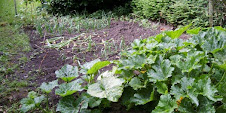The success story of the ration experiment so far has undoubtedly been heart - both ox and pig - that we have turned into fantastic, dare I say it, even delicious, and very cheap dinners, notwithstanding the rather grizzly process of dealing with them. At the beginning of week two, we scored a couple of slices of ox heart from one of the butchers down at the indoor market, and half a pound of pig liver for about £2.50 in total. Paul took the job of cutting up the heart, discarding valves, fat, membranes and congealed blood (eep), into bitesize chunks, which we then fried after dusting in flour for the basis of a hearty (teehee) stew, with onions, carrots, broccoli and potatoes. The flavour, deglazed from the frying pan with a bit of hot stock, was deep and rich and gave the stew a good brown colour. You do have to cook heart for a good long time to tenderise it, so we left the stew, stirring occasionally for about 2 or 2 and a half hours, with a few bay leaves and other herbs to add some zing. In all honesty, it was just as good as the cheap pot of stew my good ol' mum used to make with braising steak, which itself is quite a rubbery, unpleasant meat if you don't cook it right. Very tasty indeed! And extremely economical, as two large slices of ox heart gives enough meat to serve 3 or 4 people; as we are ridiculous gluttons, we polished it all off ourselves.
A couple of nights later, Paul rustled up a traditional liver and onion dish, which was also very tasty but a bit too rich for me personally. Perhaps we just made too much of the stuff, because a little liver really does go a long way, and it felt like I was eating a massive hunk of pate. Much as I do like a nice bit of pate, half a plateful is probably overkill. Anyway, with the leftover liver, and a bunch of vegetable peelings, we made a killer stock, which was then used to good effect in a beef mince chilli, which used up our meat ration for week two. On the nights in between these meaty feasts, we had more simple fare based around potatoes and vegetables, which actually comes as quite a welcome relief for someone like me who isn't used to eating a lot of red meat. But for the meantime, chicken and seafood are off the menu, the former being far too expensive (if you go down the free range route, and I'm not prepared to start buying tortured chickens) and the latter presumably being a lot more difficult to come by unless you live by the seaside, which unfortunately for the time being, we don't. It is a treat to be able to indulge in a bit of rainbow trout, of which Paul has accumulated a stockpile, every now and then. We also had dinner round at Paul's mum's house one night and she made us egg and chips, which was awesome, although we did break the rules and have two eggs each, when we're really only supposed to have access to one. However, Paul's mum raises chickens, who are going through a laying spree at the moment, so it seems fair enough that we can have a couple of extra ones due to this happy circumstance.
In week 3, I experimented with a great recipe for pig heart that I found online, attractively called "Love in Disguise", which was a bit more labour intensive than the stew (and I had to handle the grizzly business myself this time)but ultimately worth it. Check it out and try it if you dare! For those less au fait with congealed blood, I also came up with a recipe that is a great way to make the most out of new season potatoes and flourishing courgettes, and is pretty light on calories. Take a couple of potatoes, a courgette, a couple of tomatoes, an onion and a few mushrooms, and slice them all reasonably thin. Then, alternately layer each thing in an ovenproof dish three or four times, depending on the size of the dish. After each layer, sprinkle a little salt, pepper, oregano (or other herb of preference), crushed garlic and cooking oil (olive oil if you're allowed it). Finish off with a layer of potato and drizzle with a little more oil; cover the dish with foil and bake for 45minutes to an hour (again depending on dish size) at about 190C. After this time, remove the foil and test if the potatoes are soft. If not, put the foil back on and cook for a little longer. Once the potatoes are soft, take the foil off, sprinkle on some grated cheese and bake it for 5 or 10 minutes more until the cheese is melted and bubbly delicious. Yum, yum. You can basically use any sliceable vegetable for this recipe - butternut squash works really well, for instance - but I would recommend always putting in a bit of tomato as the liquid that comes out of them helps to steam the other layers.
We're having sausages tonight, I'm hungry already!!
Friday, 19 June 2009
Subscribe to:
Post Comments (Atom)

No comments:
Post a Comment